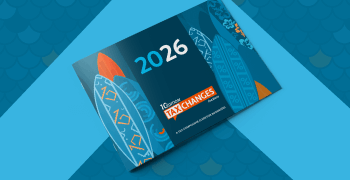
How to ensure the right sales tax rate is applied to each transaction
The explosive growth of ecommerce has coincided with expanding state sales tax collection requirements. Together, these two factors can complicate sales tax compliance for online retailers, requiring them to track thousands of different sales tax rates and reporting codes.
Ecommerce has been an essential sales channel practically since its inception. In 1998, just a few years after Amazon sold its first book online, ecommerce accounted for 0.2% of total retail trade. By 2018, ecommerce represented 14.3% of total retail trade.
The COVID-19 pandemic has certainly accelerated the growth of ecommerce. As the virus took hold of the nation, forcing brick-and-mortar stores to temporarily close or cap capacity, selling online became key to the survival of many retailers. The numbers bear that out: In 2020, online spending accounted for an estimated 21.3% of total retail sales for the year, an increase of 44% over 2019.
While selling online is helping many businesses stay solvent in the time of COVID-19, it may also expand their sales tax nexus footprint.
Nexus creates a sales tax collection obligation
Nexus is a connection between a business and a state that enables the state to require the business to register then collect and remit sales tax. Having a physical presence in a state, such as a store or even inventory, creates nexus. A business can also create nexus solely through economic activity in a state (e.g., $100,000 in annual sales). Economic nexus has been adopted by all states with a sales tax except Florida and Missouri.
As sales continue to grow for online retailers, their likelihood of establishing economic nexus in one or more states grows, too. And once they trigger an obligation to collect sales tax in another state, retailers need to ensure they collect at the right rate in each jurisdiction.
It’s a big task.
There are more than 12,000 sales tax jurisdictions in the United States
Forty-five states and Washington, D.C., have a statewide sales tax, and 38 states have local sales taxes. There’s no general sales tax in Alaska, Delaware, Montana, New Hampshire, and Oregon, although Alaska does allow local sales taxes.
All told, there are more than 12,000 different sales and use tax jurisdictions in the U.S.: Oklahoma has about 580 sales tax jurisdictions, and Texas roughly 1,500. On top of state, county, and municipal jurisdictions, there are numerous special districts, including but not limited to ambulance districts, economic development districts, school districts, and transportation districts. It’s common for local and special districts to overlap.
At least one sales and use tax rate is associated with each jurisdiction, and some jurisdictions — like many in Missouri — allow different rates for use tax, food, utilities, and more. For each transaction, sellers must collect the total combined rate in effect where the sale is sourced: the state rate (except in Alaska) plus all applicable local and special district rates.
Businesses selling into multiple jurisdictions can easily become overwhelmed by the enormity of the task of assigning the proper rate to each transaction. Those using ZIP codes to determine sales tax rates soon learn ZIP codes don’t necessarily align with sales tax jurisdictions. In the city of Boulder, Colorado, for example, jurisdiction code 07-0003 includes ZIP codes 80304 and 80301.
Furthermore, tax rate tables quickly become outdated. There were more than 34,000 sales and use tax rate and taxability changes in the U.S. and Canada in 2019. Every time a change occurs in a jurisdiction, the tax rate table for that jurisdiction needs to be updated.
Geolocation: the right tool for the job
Geolocation technology helps ensure businesses selling into multiple jurisdictions apply the most up-to-date rates and rules to each transaction. It generates rates with rooftop-level precision — and assigning rates and rules to the rooftop is essential.
Different sides of a street can have different sales tax rates
It’s surprisingly common for there to be different sales tax rates on different sides of the same street. In Colorado Springs, for example, the sales tax rate on the east side of E. Las Vegas Street is 8.2%, while the rate on the west side of E. Las Vegas Street is 5.13%.
Kansas is a veritable poster child for complicated sales tax calculations. Special districts often include even-numbered addresses on some streets but odd-numbered addresses on others. And of course, special districts come and go and are subject to change, as this rate change notice for April 2021 reveals. Here’s a mind-boggling snapshot.
In most cases, product taxability rules on either side of a street will be the same even if the rates are different, but not always.
For example, in the town of Bristol, the north side of W. State Street is in Virginia while the south side of W. State Street is in Tennessee. Thus, taxability rules on the north side of the street are governed by Virginia law and taxability rules on the south side of the street are governed by Tennessee law.
During Tennessee’s annual sales tax holiday, which typically takes place the last weekend of July, qualifying clothing, computers, and school supplies are exempt from Tennessee sales tax on the Tennessee side, but subject to Virginia sales tax on the Virginia side. The following weekend, products qualifying for the Virginia sales tax holiday are exempt from sales tax on the Virginia side but taxable on the Tennessee side.
It’s complicated. The fact that sales tax rates are subject to frequent change makes it more so.
Sales tax rates and reporting requirements can change
Counties and municipalities in Alabama are required to notify the Alabama Department of Revenue in writing at least 60 days prior to the effective date of a new tax or an amendment. However, the department sometimes doesn’t receive or post rate change notices until a few days before a change takes effect — or even weeks or months after a change took place.
The notices often pertain to new tax levies or changing rates, but sometimes they announce a reporting code change, and sometimes an administrative change. Like Colorado, Louisiana, and several other states, Alabama is a home rule state, meaning local governments have the authority to administer and collect their local sales taxes. Some do, while others have the Alabama Department of Revenue administer and collect local taxes on their behalf.
Periodically, a local tax authority will discontinue the services rendered by the Alabama Department of Revenue, opting to administer local sales tax itself. And periodically the inverse is true, and a local government will ask the state tax authority to administer and collect sales tax on their behalf.
For ecommerce businesses with an obligation to collect and remit sales tax in Alabama, it’s a lot to keep track of. They need to update point-of-sale systems to reflect all rate changes, and they may need to report and remit some local sales taxes to local tax authorities while filing others with the Alabama Department of Revenue. And that’s just one state.
Sales tax holidays and product taxability changes
Rates for specific products are also subject to change in all states. Recently, several states imposed new taxes on soda and other sweetened beverages; others carved out new exemptions for diapers and/or feminine hygiene products.
Thousands of normally taxable products are temporarily exempt during state sales tax holidays. For example, Alabama’s sales tax holiday for severe weather preparedness and Maryland’s energy efficient appliances sales tax holiday affected almost 7,000 different products in February 2021, and that’s just two tax-free periods. Approximately 17 states have one or more sales tax holiday(s) each year, and in 2019, there were more than 115,000 U.S. sales tax holiday rule updates.
Because of sales tax holidays, rate and product taxability changes, boundary changes, and other factors, businesses aren’t able to simply set sales tax rates in their point-of-sale systems and forget about them. They need to constantly be on the lookout for changes that will affect their compliance and adjust point-of-sale systems and sales tax collection and reporting as needed. Applying an incorrect rate or code to a transaction can lead to shopping cart or system errors.
Automating sales tax compliance is the better option. Avalara AvaTax is a cloud-based sales and use tax calculation solution that relies on geolocation technology to pinpoint exact locations. It takes special rates and circumstances into account, such as product-specific rates and sales tax holidays, and it monitors business activities, alerting you when you’re at risk of establishing nexus in a new jurisdiction.

Avalara Tax Changes 2026 is here
The 10th edition of our annual report engagingly breaks down key policies related to sales tax, tariffs, and VAT.
Stay up to date
Sign up for our free newsletter and stay up to date with the latest tax news.














